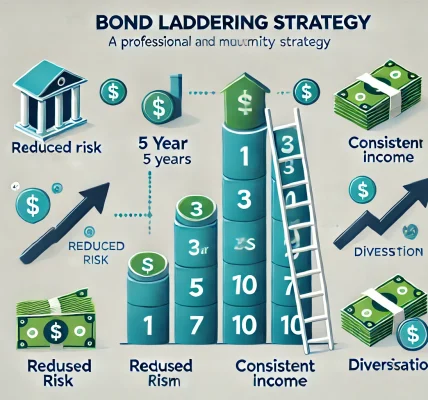In a world of fluctuating interest rates, investors often seek instruments that protect their capital while offering reasonable returns. Floating rate bonds (FRBs) are an excellent option in a rising interest rate environment, as their interest payments adjust periodically based on prevailing market rates.
In this in-depth guide, we explore the features, benefits, and risks of floating rate bonds, analyze their performance during rising interest rates, and provide insights on how they can fit into your investment portfolio.
📚 What Are Floating Rate Bonds?
💡 Definition
A floating rate bond (FRB), also known as a variable rate bond, is a type of debt instrument where the interest rate is periodically adjusted based on a benchmark interest rate. Unlike fixed-rate bonds that pay a constant interest rate throughout their tenure, FRBs adjust their interest rates, usually every 3 to 6 months, based on prevailing market conditions.
📊 How Do Floating Rate Bonds Work?
- Coupon Rate Adjustment: The coupon rate (interest rate) is linked to a benchmark rate such as the LIBOR, MIBOR, SOFR, or RBI’s Repo Rate.
- Reset Period: Interest payments are reset periodically (quarterly, semi-annually) based on the benchmark rate.
- Interest Payout: Investors receive variable interest payments that fluctuate in tandem with changes in benchmark rates.
📈 Example of a Floating Rate Bond
- A floating rate bond issued with a coupon rate of LIBOR + 2% means that if LIBOR is 3%, the bond will pay a total interest of 5%.
- If LIBOR increases to 4%, the coupon payment increases to 6%, offering higher returns to bondholders.
📝 Why Consider Floating Rate Bonds in a Rising Rate Environment?
🔼 1. Protection Against Rising Interest Rates
When interest rates rise, the value of traditional fixed-rate bonds tends to fall because their fixed payments become less attractive compared to new bonds with higher rates. However, floating rate bonds adjust their coupon payments to reflect the higher interest rates, maintaining their attractiveness.
📊 2. Higher Returns During Rate Hikes
As central banks raise interest rates to combat inflation, floating rate bonds offer increasing yields, ensuring investors benefit from a rising rate environment.
🔄 3. Low Interest Rate Sensitivity (Duration)
Floating rate bonds have low duration, meaning they are less sensitive to changes in interest rates, reducing the risk of price volatility.
📉 4. Reduced Price Volatility
Since interest rates adjust periodically, the bond’s price remains relatively stable, offering protection against capital losses during rising interest rates.
🔎 Key Features of Floating Rate Bonds
📈 1. Variable Coupon Rate
The interest rate fluctuates periodically in line with benchmark rates.
⏰ 2. Reset Frequency
Coupons are adjusted every 3, 6, or 12 months based on the bond’s terms.
📊 3. Benchmark Linkage
Coupon rates are linked to various benchmark rates such as:
- LIBOR (London Interbank Offered Rate)
- MIBOR (Mumbai Interbank Offered Rate)
- SOFR (Secured Overnight Financing Rate)
- RBI Repo Rate (India-Specific Bonds)
⚖️ 4. Maturity and Principal Repayment
FRBs typically have medium to long-term maturities, and the principal is repaid upon maturity, similar to traditional bonds.
📝 Advantages of Floating Rate Bonds
🔼 1. Rising Income Potential
FRBs allow investors to benefit from rising interest rates by providing higher coupon payments.
📉 2. Lower Interest Rate Risk
Unlike fixed-rate bonds, FRBs are less vulnerable to declining bond prices during periods of rising interest rates.
💡 3. Portfolio Diversification
Incorporating floating rate bonds adds diversification to an investment portfolio, reducing overall risk.
💸 4. Suitable for Conservative Investors
FRBs offer a relatively safer option for conservative investors who want to limit interest rate risks while maintaining a steady income.
⚠️ Risks Associated with Floating Rate Bonds
📉 1. Falling Interest Rates
If interest rates fall, the coupon payments on floating rate bonds also decline, resulting in lower income for investors.
⏳ 2. Uncertainty in Income
Since the interest rate fluctuates periodically, investors may not predict future income accurately.
📊 3. Credit Risk of Issuer
Corporate floating rate bonds may carry credit risk if the issuer defaults on its obligations.
⚖️ 4. Market Liquidity Risk
FRBs with longer maturities may experience liquidity risk during periods of market stress.
🔎 Comparing Floating Rate Bonds and Fixed-Rate Bonds
| Feature | Floating Rate Bonds | Fixed-Rate Bonds |
|---|---|---|
| Interest Rate Risk | Low | High |
| Coupon Variability | Variable | Fixed |
| Suitability in Rising Rates | High | Low |
| Price Stability | More Stable | Less Stable |
| Return Predictability | Low | High |
📈 When Should You Invest in Floating Rate Bonds?
✅ 1. Rising Interest Rate Environment
Invest in floating rate bonds when central banks signal rate hikes to control inflation.
📊 2. Periods of Economic Expansion
When the economy is expanding, interest rates tend to rise, making floating rate bonds an attractive option.
🔍 3. Inflationary Periods
During inflation, central banks may tighten monetary policies by raising interest rates, which benefits floating rate bondholders.
🛡️ How to Mitigate Risks in Floating Rate Bonds
📚 1. Diversify Across Issuers and Maturities
Invest in floating rate bonds issued by diverse entities to minimize credit risk and spread the impact of fluctuating rates.
📉 2. Combine Floating and Fixed-Rate Bonds
Maintain a balance between floating and fixed-rate bonds to achieve optimal portfolio performance.
⚖️ 3. Consider Investment-Grade Bonds
Prioritize investment-grade floating rate bonds to minimize credit risk.
📊 4. Review Bond Reset Frequencies
Opt for bonds with frequent reset periods to ensure quicker alignment with rising interest rates.
📝 Evaluating Floating Rate Bond Performance
📊 1. Yield to Maturity (YTM)
Indicates the total return expected if the bond is held until maturity.
🔄 2. Spread Over Benchmark Rates
Higher spreads often indicate higher yields but may come with increased credit risk.
⚠️ 3. Credit Rating of the Issuer
Opt for bonds with higher credit ratings to reduce default risk.
💡 Legal Considerations for Floating Rate Bonds
⚠️ 1. Disclosures and Transparency
Ensure the terms of the floating rate bond, including the benchmark rate and reset frequency, are clearly disclosed.
⚖️ 2. Compliance with Regulatory Standards
Adhere to relevant guidelines set by regulatory bodies such as SEBI in India or SEC in the U.S.
📚 3. Avoid Misleading Advice
Present information factually, avoiding personalized financial recommendations.
💡 Steps to Include Floating Rate Bonds in Your Portfolio
✅ 1. Define Investment Objectives
Determine your risk appetite, return goals, and investment horizon.
📚 2. Evaluate Credit Quality and Benchmark Rates
Choose FRBs issued by reputable entities and linked to stable benchmark rates.
🔍 3. Monitor Interest Rate Trends
Regularly review interest rate movements and adjust your portfolio accordingly.
⚖️ 4. Rebalance Portfolio Periodically
Maintain a healthy balance between floating and fixed-rate investments to achieve risk-adjusted returns.




